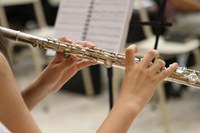Prairie Fare: Is Music Good for Your Health?
(Click an image below to view a high-resolution image that can be downloaded)
By Julie Garden-Robinson, Food and Nutrition Specialist
NDSU Extension
“It sounds good, Mom,” my daughter said encouragingly.
I muttered something under my breath.
Actually, I had very little breath left in me. I was ready to collapse on the floor.
I wasn’t writing an article, as I usually do in our home office. I was at my computer with a folder full of music stretched out in front of me. I had my flute in my hands and I was playing marches filled with runs and trills along with YouTube videos.
Here’s a tip: Don’t sight-read music along with commissioned musicians in armed forces bands on YouTube. They play marches exceptionally fast. Practice first.
I felt as though I had just gotten my learner’s permit and I was driving in the Indianapolis 500, narrowly avoiding hitting a wall.
For the past few months, I have reacquainted myself with band music. At the encouragement of a colleague, I joined the Shrine Circus Band and the Red River Valley Veterans Band.
After a lackluster first attempt at practicing marches for the circus, I color-coded all the repeats and key changes in the music. I played all 40 marches consecutively without a break two nights in a row.
With each band performance, the music grew easier as my brain, fingers, lips and lungs got in sync with each other.
As I looked around at the musicians, who range in age from about 20 to more than 80, I thought of the collective years of practice involved in playing an instrument. I also thought about the dedication and love of music that kept them playing. Music has lifelong value.
I decided to read some research articles about the health benefits of music. Based on what I learned, I won’t be giving up the flute, piano or singing any time soon.
I encourage you to find your high school clarinet (or whatever instrument), or break out the piano lesson books you put away in fifth grade. Or just listen to music regularly.
Every civilization since the dawn of time has enjoyed music. Archeologists have found flutes carved from animal bones from distant eras. They probably had a few drummers back then, too.
Most people like some kind of music, whether it’s classical, country, jazz, rap, rock or a good march.
Whether you play music or listen to it, music enlists various parts of our brain. Keeping our brain active is important for us throughout our lives. Listening to music can enhance the ability to think and process information, and it may be protective against dementia.
Singing can help patients recover their speech after strokes. Listening to marches may help people with Parkinson’s disease improve their ability to walk.
Music can reduce stress levels, and help lower blood pressure and heart rate. Anyone who ever has tuned into certain music after a particularly good or bad day knows that music can help us celebrate or lift our spirits.
Clinically, music can help those with depression and/or anxiety.
Music can be used therapeutically with patients who are recovering from surgery, in cancer treatment or those with ongoing pain.
I have learned the most value of music as I observe our audience members, especially when the Veterans Band plays concerts in nursing homes. Music touches people deeply and invokes memories of the past.
Sometimes our audience laughs and claps when we play polkas. Other times, tears flow down their faces as we play songs from bygone eras, including military service songs.
As I have found, sometimes reading the notes on the page gets a little difficult when your eyes are welling as you see the profound effect music can have on people.
I always feature a recipe in this column, but does music have any connections to food? Unfortunately, beans have the reputation of being the “musical fruit.” According to researchers, the more you eat beans, the less likely you will “toot.”
Beans, which technically are vegetables or protein foods, are considered “prebiotic.” That means they feed the healthy bacteria in your gut. They also contain fiber that’s good for your heart and digestive system.
Most adults shortchange themselves on the 25 to 38 grams of fiber needed daily. Black beans have about 8 grams of fiber per half cup. When increasing your fiber, increase your water intake, too.
Check out https://www.ag.ndsu.edu/food and navigate to Healthwise for Guys and/or Healthwise for Women under “Programs” for more information.
Turn on a little Mexican fiesta music as you enjoy this recipe, which can be a taco filling or a bean dip. It’s courtesy of Northarvest Bean Growers.
Baja Bean Tacos
1/2 c. onion, chopped
1 Tbsp. cooking oil, such as canola, sunflower, soybean
1 (15 1/2-ounce) can kidney beans, drained and rinsed
1 (15 1/2-ounce) can pinto or black beans, drained and rinsed
2 tsp. chili powder
1/4 tsp. cumin
1/4 tsp. garlic powder
1/4 tsp. onion powder
1/4 tsp. black pepper
1 c. cheddar cheese, shredded
1/2 c. Monterey Jack cheese, shredded
12 (6-inch) corn or tortilla tacos
1 1/2 c. lettuce, shredded
3/4 c. tomato-based salsa, mild or medium
3/4 c. sour cream or yogurt
Saute onion in oil until tender, about five minutes. Drain and rinse beans in water in colander. Coarsely chop or mash kidney beans. Combine beans, onions, spices and cheese. Pour mixture into greased 1 1/2-quart casserole dish. Bake, covered, in a 350 F oven for 20 to 30 minutes until heated through. To serve, scoop 1/4 cup filling into each taco, top with 2 tablespoons lettuce and 1 tablespoon of salsa and sour cream or yogurt. Roll tortillas and serve. Alternatively, this mixture can be used as a bean dip with tortilla chips.
Makes six servings, with two tacos per serving. Each serving has 452 calories, 19 grams (g) fat, 19 g protein, 49 g carbohydrate, 12 g fiber, and 736 milligrams sodium.
(Julie Garden-Robinson, Ph.D., R.D., L.R.D., is a North Dakota State University Extension food and nutrition specialist and professor in the Department of Health, Nutrition and Exercise Sciences. Follow her on Twitter @jgardenrobinson)
NDSU Agriculture Communication - April 11, 2019
| Source: | Julie Garden-Robinson, 701-231-7187, julie.garden-robinson@ndsu.edu |
|---|---|
| Editor: | Ellen Crawford, 701-231-5391, ellen.crawford@ndsu.edu |



